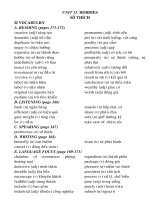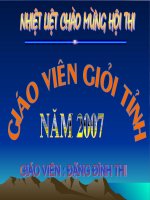UNIT 12 Monetary Policy
Bạn đang xem bản rút gọn của tài liệu. Xem và tải ngay bản đầy đủ của tài liệu tại đây (1.54 MB, 23 trang )
UNIT 12: MONETARY POLICY
GROUP 9:
MEMBERS:
Đỗ Thị Lan Phương
Nguyễn Thị Hương
Lê Thị Yến Oanh
Welcome to unit 12
Monetar y Policy
Group 10
Teacher: Ph m Th Tâmạ ị
Members:
Nguy n Th H ngễ ị ươ
Đ Th Lan Ph ngỗ ị ươ
Lê Th Y n Oanhị ế
Class: 21.07LT2
I. NEW WORDS
/r z rv/ɪˈ ɜ
/'kw ntit tiv/ɔ ə
/di'p zit/ɔ
/'p :tli/ɑ
/d pend/ɪˈ
/kæ /ʃ
/kle m/ɪ
/di'p zit /ɔ ə
/ l t n t v/ɔː ˈ ɜː ə ɪ
/ d ska nt reit/ˈ ɪ ʊ
/ k spend/ɪ ˈ
/ p r e n/ˌɒ ə ˈ ɪʃə
/ mek n z m/ˈ ə ɪ ə
/ ft/ʃɪ
/d za r/ɪˈ ɪə
/d sp z bl/ɪˈ əʊ ə
/ n k r d /ɪ ˈ ʌ ɪ ʒ
/ra t /w d/ɪ ɔː
/ k ses v/ɪ ˈ ɪ
/d s r pt/ɪ ˈ ʌ
/ les n/ˈ ə
/ k spend t r/ɪ ˈ ɪ ʃə
//r z rv r kwa m nt/ɪˈ ɜ ɪˈ ɪə ə
/s kj r ti/ɪˈ ʊə ə
/ pra m ri m k t/ˈ ɪ ə ˈ ɑː ɪ
/ æ r t d m nd/ˈ ɡ ɪɡə ɪˈ ɑː
/r str kt v/ɪˈ ɪ ɪ
/'æset/
/lo n/ʊ
/ lt r/ˈɔ ə
Reserve
Quantitative
Deposit
Partly
depend
cash
claim
depositor
alternative
discount rate
/r z rv/ɪˈ ɜ
/'kw ntit tiv/ɔ ə
/di'p zit/ɔ
/'p :tli/ɑ
/d pend/ɪˈ
/kæ /ʃ
/kle m/ɪ
/di'p zit /ɔ ə
/ l t n t v/ɔː ˈ ɜː ə ɪ
/ d ska nt reit/ˈ ɪ ʊ
S d trự ự ữ
Đ nh l ngị ượ
Ti n g i NHề ử
M t ph nộ ầ
Ph thu cụ ộ
Ti n m tề ặ
Đòi h iỏ
Ng i g i ti nườ ử ề
D phòngự
Lãi su t chi t kh uấ ế ấ
expand
operation
mechanism
shift
desire
disposable
ecourage
rightward
excessive
Disrupt
/ k spend/ɪ ˈ
/ p r e n/ˌɒ ə ˈ ɪʃə
/ mek n z m/ˈ ə ɪ ə
/ ft/ʃɪ
/d za r/ɪˈ ɪə
/d sp z bl/ɪˈ əʊ ə
/ n k r d /ɪ ˈ ʌ ɪ ʒ
/ra t /w d/ɪ ɔː
/ k ses v/ɪ ˈ ɪ
/d s r pt/ɪ ˈ ʌ
M r ngở ộ
Quá trình HĐ
C c uơ ấ
S thay đ iự ổ
Mong mu nố
Kh d ngả ụ
Khuy n khíchế
V bên ph iề ả
Quá m cứ
Gây c n trả ở
lessen
expenditure
reserve requirement
security
primary market
aggregate
demand
restrictive
asset
/ˈlesən/
/ɪkˈspendɪtʃər/
//rɪˈzɜrv rɪˈkwaɪəmənt/
/sɪˈkjʊərəti/
/ˈpraɪməri ˈmɑːkɪt/
/ˈæɡrɪɡət dɪˈmɑːnd/
/rɪˈstrɪktɪv/
/'æset/
Giảm bớt
Khoản chi tiêu
Dự trữ
bắt buộc
Chứng khoán
Thị trường sơ cấp
Tổng cầu
Hạn chế
Tài sản
Monetary
Policy
Quantitative
Tools of
Monetary
Policy
Reserve
requirement
Discount rate
Open market
operations
The central
bank’s
control over
the supply
of money
Expansionary
monetary policy
Restrictive
monetary policy
II. Summary
Firstly, it talks about quantitative tools of monetary
policy.
There are 3 tools of monetary policy:
1. Reserve requirement:
.
the reverse requirement is the percentage the Fed sets
as the minimum amount of reserves as bank must have.
.
The reserve requirement play a central role in how
much money banks have to lend out.
1. Discount rate: it is the rate of interest the Fed charge
for those loans.
2. Open market operations: it means the Fed’s buying and
selling Gov. securities.
Secondly, the central bank’s control over the supply
of money. There are two kinds of monetary policy.
Expansionary MP:
o
It may be used to increase money supply by reducing
reserve requirement, discount rate and buying more
bonds. It will result in a rightward shift of the
aggregate demand.
Restrictive:
o
it may be used to cool an overheating economy by
increasing reserve requirement, discount rate and
selling more bonds. it will curtail investment,
consumption, and even Gov. expenditure.
III. Short Questions
1. What is Monetary Policy?
Monetary Policy is a government policy
related to a nation’s money supply by each
country’s Central Bank.
2. How many tools of monetary policy?
There are 3 tools of monetary policy:
Reserve requirement
Discount rate
Open market operations.
3. What is called reserve requirement?
Reserve requirement is the
percentage the Fed sets as the minimum
amount of reserves as bank must have.
4. What determines the amount banks hold
as reserves?
It is the Fed's reserve requirements.
5. What is the central role of the reserve
requirements?
The reserve requirement play a central
role in how much money banks have to lend
out.
6. What is the discount rate?
The discount rate is the interest rate
that the Fed charges when it lend money to
the bank.
7. What are open market operations?
It is the Fed’s buying and selling
government security.
8. How can the Central Bank shift
Aggregate demand?
By making more or less money
available, the Central Bank can shift
aggregate demand.
9. What can the Central Bank do to reduce
aggregate demand?
They can increase reserve
requirements, raise discount rate or sell
bonds.
IV. LONG QUESTIONS
1. what are the quantitative tools of monetary policy?
The quantitative tools of monetary policy include reserve
requirement, discount rate and open market operations.
By changing the reserve requirements, discount rate the Fed can
increase or decrease the money supply.
To contract the money supply, the Fed increases the reserve
requirement, thus banks have keep more reserves so they have
less money to lend out and vice versa.
To contract the money supply, the Fed increases the discount
rate. An increase in the discount rate makes the loans more
expensive for banks to borrow from the Fed and vice versa.
For day – to – day Fed operations, the Fed used a third tool:
open market operations.
To expand the money supply, the Fed buys bonds. To contract
the money supply, the Fed sells bonds.
2. What is the difference between monetary policy and
fiscal policy?
There are several differences here.
Monetary policy controls a nation's money supply
which is supervised by each country's Central Bank
while fiscal policy is related to government's revenue
and spending which is in the hand of Ministry of
Finance.
3 main tools of monetary policy are reserve
requirements, Discount rate and open market
operations. On the other hand, fiscal policy uses
taxation and government spending as its 2 main tools.
3. What is the relationship between monetary policy
and fiscal policy?
They have an interdependent and
complement relationship since they are many
overlapping issues between the two fields.
For example, if Gov. decide to institute expansionary
fiscal policy, they reduce taxes or increase their
expenditure, so that a large amount of money will be
supplied and aggregate demand will rise consequently.
As a result, Gov. have to use restrictive monetary
policy to reduce the inflation rate.
4. What is the difference between expansionary
monetary policy and restrictive monetary policy?
There are some differences here.
Expansionary monetary policy is used to
increase the amount of money supply, whereas
restrictive one is used to decrease it.
Expansionary one can increase bank lending
capacity while restrictive one will decrease it.
Thanks
for your
listening
!









